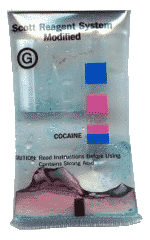|
What is the blue-color change test used to detect cocaine by cops and border patrol?
| Q: |
What is the blue-color change test used to detect cocaine by cops and border patrol? |
|
| A: |
You're probably thinking of the cobalt-thiocyanate reagent which turns blue in contact with cocaine, but is not, by itself, a definitive test for it. As with most field tests, the most that can be said for certain is that if no color change occurs with this reagent, then the target substance is not present at detectable quantities. These tests also are only for testing for drugs in solid form and are not used to detect drugs in the blood or urine.
The cobalt-thiocyanate test also turns blue for PCP and is used as a field test for it.
Sigma, a chemical manufacturer, has a nice page on this reagent including a list of substances which can cause the reagent to turn blue at http://www.sigma.sial.com/sigma/techinfo/qtcoca.htm. The list of other substances that turn blue include atropine, codeine, diphenhydramine (Benadryl), methamphetamine, ritalin, psilocin, quinine, and many others. Also, the ambient temperature where the test is conducted (very cold, or especially very hot) can impact the results, according to chemists from Southeast Missouri State University.
Another good source of info is the UNDCP's page on the chemistry of cocaine. The UNDCP describes some of the development around the cobalt thiocyanate test and different reagent combinations that have been developed to increase specificity. The most interesting piece of information from this page is that bleach (sodium hypochlorite solution) may be a better field test for cocaine than the much more obscure and expensive cobalt-thiocyanate.(R.W. Samuels, "Evaluation of sodium hypochlorite as a screening agent for the identification of cocaine", Clinical Toxicology , vol. 12, 1978, pp. 543 -550.)

Drug Testing Ltd, a retailer of field tests for cocaine and other drugs has some nice pictures of some of the self-contained single use tests that are available to law enforcement. The substance is dumped into the little plastic pouch and either a drop of reagent is added to the pouch which is then sealed and shaken, or a glass capsule in the pouch is broken that contains the reagent.
I hope that helps,
earth |
|
|
|
|
|
Categories:
[ Drug Testing ]
[ Cocaine ]
|
|



